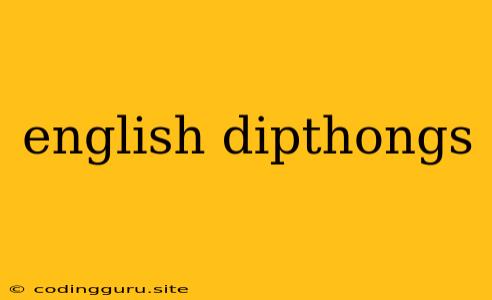Unlocking the Secrets of English Dipthongs: A Comprehensive Guide
English, a language known for its rich and complex sounds, utilizes a fascinating array of vowel combinations called dipthongs. These unique sounds are formed by gliding smoothly from one vowel sound to another within a single syllable. Understanding dipthongs is crucial for accurate pronunciation and clear communication in English. Let's delve into the world of dipthongs, exploring their characteristics, types, and how they contribute to the beauty and nuance of the English language.
What are Dipthongs?
Dipthongs are vowel sounds that involve a movement or glide from one vowel position to another within the same syllable. Imagine a smooth transition between two vowel sounds, creating a unique sound that is distinct from either of its component vowels. For instance, the dipthong in the word "buy" starts with the "ah" sound of "father" and smoothly glides towards the "ee" sound of "see".
The Eight English Dipthongs: A Detailed Look
English boasts eight common dipthongs, each with its distinct sound and spelling variations. Let's break them down one by one:
-
ɪə (ear): This dipthong is represented by the spelling "ear" and is found in words like "near," "beer," and "fear." The sound begins with the "ih" sound of "bit" and moves towards the "uh" sound of "but."
-
eɪ (say): This dipthong is often spelled with "ay" or "ey" and appears in words like "say," "day," and "they." It starts with the "eh" sound of "bed" and glides towards the "ee" sound of "see."
-
ɔɪ (boy): This dipthong is typically spelled with "oy" or "oi" and is found in words like "boy," "joy," and "coin." It starts with the "oh" sound of "cot" and glides towards the "ee" sound of "see."
-
aʊ (out): This dipthong is commonly spelled with "ow" or "ou" and appears in words like "out," "now," and "house." The sound begins with the "ah" sound of "father" and moves towards the "oo" sound of "boot."
-
əʊ (go): This dipthong is frequently spelled with "o" or "oe" and is present in words like "go," "no," and "toe." The sound starts with the "uh" sound of "but" and glides towards the "oo" sound of "boot."
-
eə (air): This dipthong is often spelled with "air" and is found in words like "hair," "chair," and "fair." It starts with the "eh" sound of "bed" and glides towards the "uh" sound of "but."
-
ʊə (tour): This dipthong is typically spelled with "our" or "ure" and is present in words like "tour," "pour," and "sure." The sound begins with the "uh" sound of "but" and moves towards the "ee" sound of "see."
-
aɪ (eye): This dipthong is often spelled with "i" or "y" and appears in words like "eye," "buy," and "my." The sound starts with the "ah" sound of "father" and glides towards the "ee" sound of "see."
Tips for Mastering English Dipthongs
-
Active Listening: Pay close attention to how native English speakers pronounce words containing dipthongs. Listen carefully to the smooth transition between the two vowel sounds.
-
Visualizing the Movement: Imagine the tongue moving from one position to another as you practice the dipthong sounds. Visualize the glide, starting with the first vowel and ending with the second vowel.
-
Practice with Minimal Pairs: Utilize minimal pairs, words that differ only in a single sound, to sharpen your ability to distinguish between dipthongs. For instance, "hair" and "hare," "boy" and "buy," or "bear" and "bare" are effective minimal pairs.
-
Use Flashcards: Create flashcards with words containing dipthongs on one side and the phonetic transcription on the other. Regularly reviewing these flashcards will help reinforce your understanding of the sounds.
-
Record Yourself: Record yourself speaking words containing dipthongs and listen back to identify areas that need improvement. This self-assessment will help you pinpoint pronunciation errors and make adjustments.
The Importance of Dipthongs in English
Dipthongs play a vital role in English pronunciation and comprehension. They add richness and complexity to the language, contributing to the subtle nuances of meaning and intonation. By understanding and mastering dipthongs, you will significantly enhance your ability to speak English with clarity, accuracy, and fluency.
Conclusion:
Dipthongs are an integral part of English pronunciation, adding depth and variety to the language's soundscape. By understanding their structure, practicing them regularly, and paying attention to their pronunciation in context, you can achieve greater fluency and precision in your English communication. Embrace the challenge of dipthongs, and you'll unlock a deeper appreciation for the intricacies of the English language.
